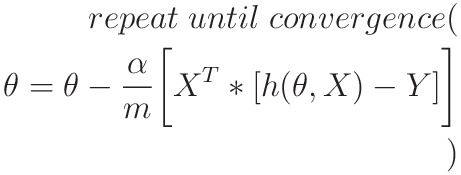Linear Regression with Multiple Variable
This is the python version of Linear Regression, most of this is converted from octave/matlab code of the Stanford Machine Learning Course from Coursera
This will be purely Mathematical and Algorithmic
Importing required libraries...
import numpy as np
import matplotlib.pyplot as plt
Functions to be used...
Let's first define the functions that will be called in actual code...
Hypothesis function
Outputs Y, Given X, by parameter θ

- m -> number of elements in the dataset
- n -> no. of features of a data (in this example 2)
- X -> m x (n+1) matrix
- +1 as we have concatenated 1 so as to keep θ0 as constant
- θ -> (n+1) x 1 matrix
- Outputs mx1 matrix
def hypothesis(x, theta):
'''calculates the hypothesis function'''
return np.matmul(x, theta)
Cost Function
This essentially calculates the distance between what we need the line to be, and what it actually is:
- Vector Form for faster implementation
- m -> number of elements in the dataset
- h(θ, X) and Y -> mx1 matrix
- Outputs 1x1 matrix

def compute_cost(x, y, theta):
'''outputs the cost function'''
m = len(y)
error = hypothesis(x, theta) - y
error_square_summed = np.matmul(np.transpose(error), error)
return 1/(2*m)*error_square_summed
Gradient Descent
Gradient Descent is an iterative way through which we can minimize the cost function J(θ,x), which essentially depends on the values of θ0 and θ1
This algorithm iteratively minimizes J(θ ,x) to reach it's minimum possible value
- Vector Implementation to speed up Algorithm:
- m -> dataset size
- n -> no. of features of a data (in this example 2)
- X -> m x (n+1) matrix
- h(θ, X) and Y -> mx1 matrix
- θ -> (n+1) x 1 matrix

def gradient_descent(x, y, theta, alpha, num_iter):
'''Performs Gradient Descent and outputs minimized theta and history of cost_functions'''
m = len(y)
J_history = np.zeros((num_iter, 1))
for iter in range(num_iter):
h = hypothesis(x, theta)
error = h-y
partial_derivative = 1/m * np.matmul(np.transpose(x), error)
theta = theta - alpha*partial_derivative
J_history[iter] = compute_cost(x, y, theta)
return theta, J_history
Normalization
As Features of X might be skewed, it is safer to normalize the features of X to same range, this reduces error, and also make learning faster

- X -> m x n matrix (note there is no +1)
- μ -> 1 x n matrix, mean of the features of X
- σ -> 1 x n matrix, standard deviation of the features of X
This essentially converts all values of a feature in the range (-1,1)
def featureNormalize(X):
mu = np.mean(X,axis=0)
sigma = np.std(X,axis=0)
X_norm = (X-mu)/sigma
return X_norm,mu,sigma
Predict
Uses hypothesis() to predict value of new input
def predict(value, minimized_theta,mu,sigma):
value = np.array(value)
mu = np.array(mu)
sigma = np.array(sigma)
mu = mu.reshape(1,mu.shape[0])
sigma = sigma.reshape(1,sigma.shape[0])
normalized_value = (value -mu)/sigma
one = np.array([[1]])
x_array = np.concatenate((one,normalized_value),axis=1)
return hypothesis(x_array,minimized_theta)
Processing
Loading Data from ex1data2.txt
The ex1data2.txt contains a training set of housing prices in Port-
land, Oregon. The first column is the size of the house (in square feet), the second column is the number of bedrooms, and the third column is the price of the house.
data_path = "./ex1data2.txt"
data = np.loadtxt(data_path, delimiter=',')
Extracting Population and Profits from data
# first value is independent variable x, second is dependant y
X= data[:, 0:2]
Y = data[:, 2]
Printing Some Data Points
print("First 10 examples from the dataset")
for iter in range(10):
print(f"X = {X[iter]}, Y = {Y[iter]}")
Normalizing
By looking in the value of X, we see that value are not in same range, so we normalize the value of X so that the learning becomes more accurate and fast
while predicting, model will give normalized output, we need to de-normalize it
X,mu,sigma = featureNormalize(X)
Adding ones to X and changing y from vector to 2D array
#adding ones to X
dataset_size = X.shape[0]
ones = np.ones(dataset_size).reshape(dataset_size,1)
X = np.concatenate((ones,X),axis=1)
Y = Y.reshape(dataset_size,1)
print(X.shape)
Running Gradient Descent
print("Running Gradient Descent ...\n")
alpha = 1
num_iter = 10
theta = np.zeros((X.shape[1],1))
minimized_theta, J_history = gradient_descent(X, Y, theta, alpha, num_iter)
print("Theta found by gradient descent:")
print(minimized_theta)
Plotting Value of J during Gradient Descent
This should Decrease with Epochs
plt.figure("Value of J during Gradient Descent")
plt.title('Value of J during Gradient Descent')
x_axis = range(len(J_history))
plt.xlabel('No. of iterations or Epochs')
plt.ylabel("Cost function J")
plt.plot(x_axis,J_history)
This will give a graph like this...

Estimate
Estimate the price of a 1650 sq-ft, 3 bedroom house
predict_input = np.array([1650,3])
predict_input = predict_input.reshape(1,predict_input.shape[0])
print(f"Predicted Price of a 1650 sq-ft, 3 bedroom house: {predict(predict_input,minimized_theta,mu,sigma)}")